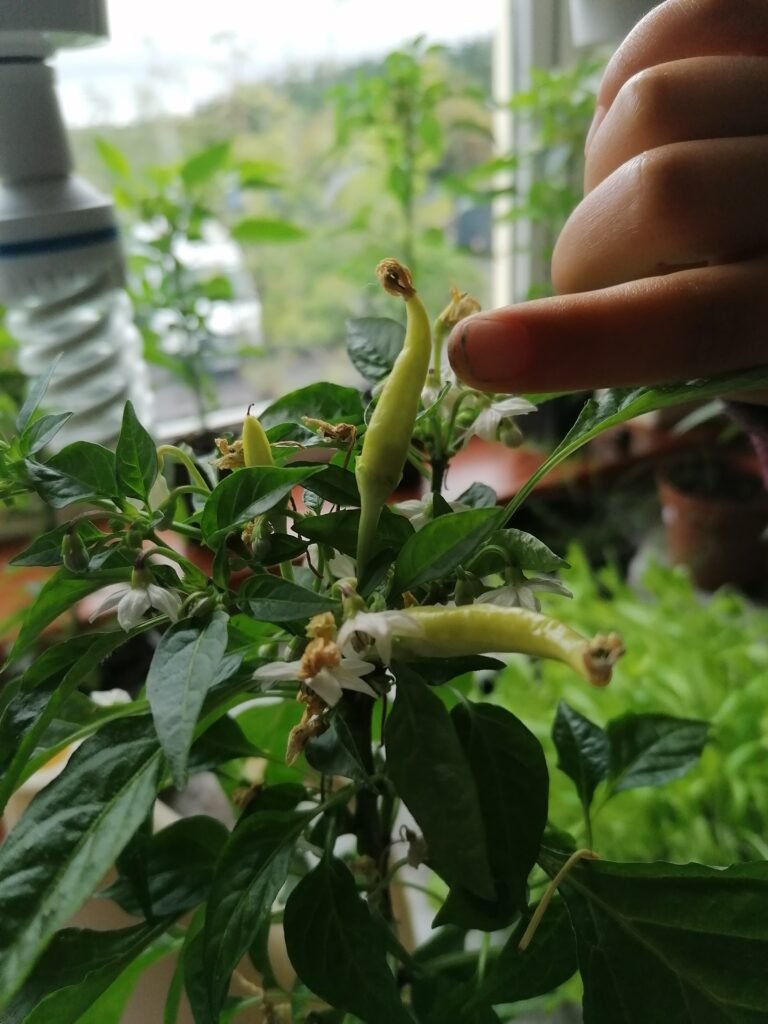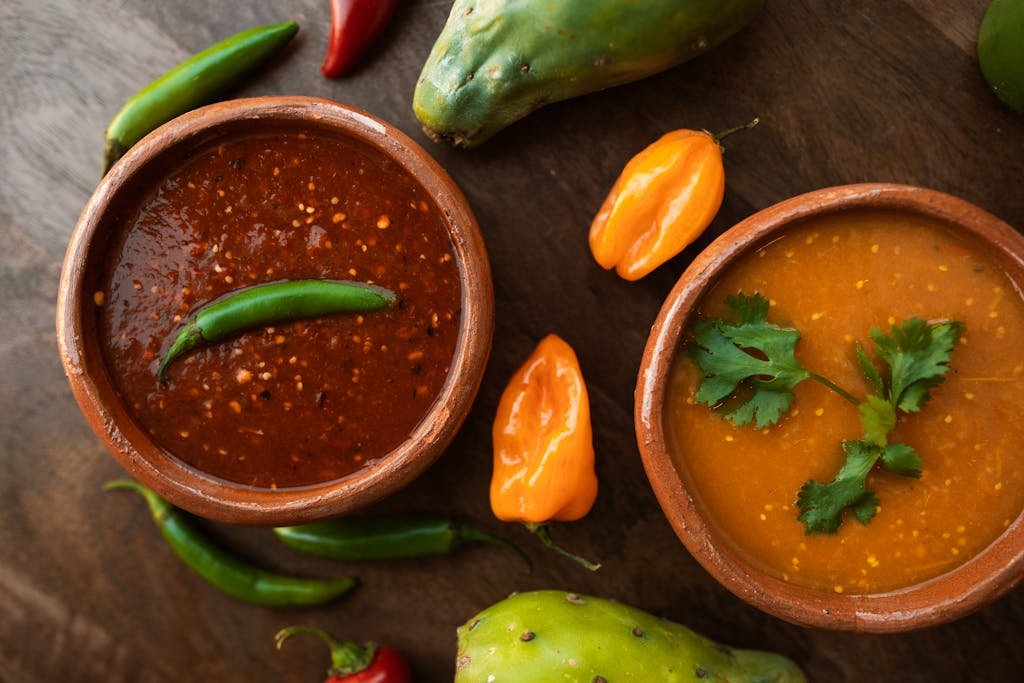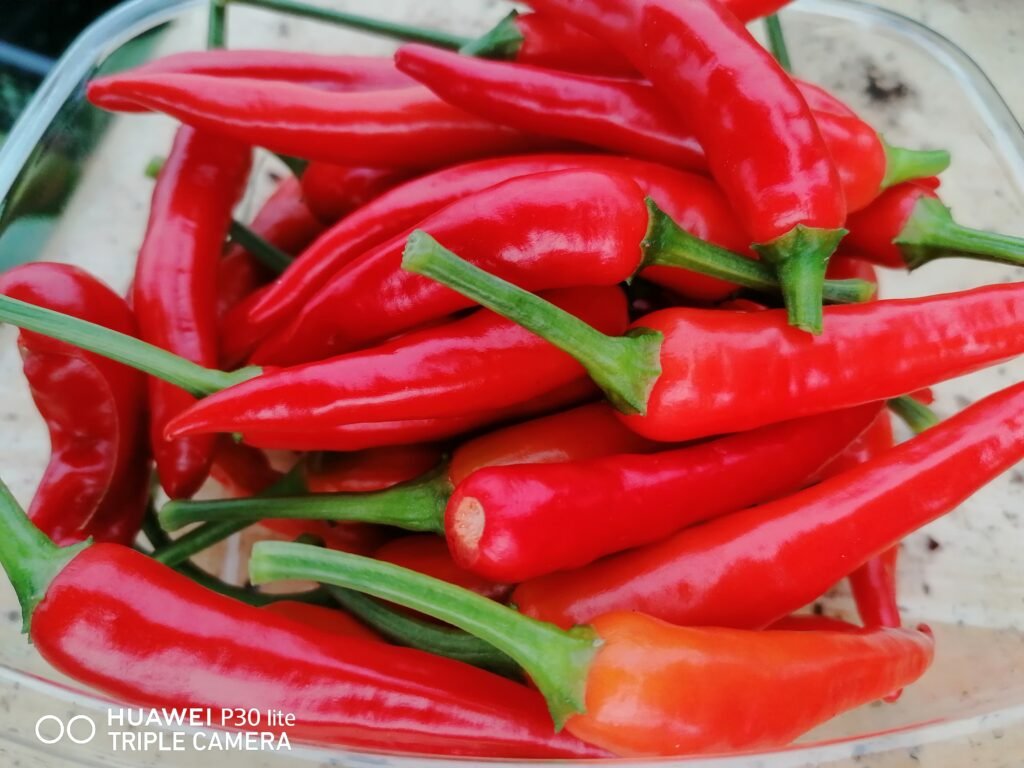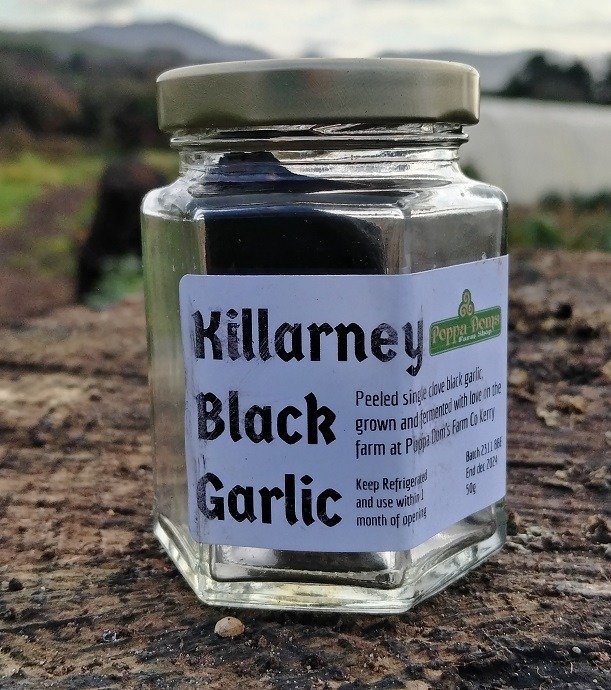Easy homemade hot sauce with fresh peppers? Yes, please! There’s something deeply satisfying about crafting your own fiery concoction from scratch—especially when those peppers come straight from the garden. We’ve been growing chilies for years, and let me tell you, nothing beats the thrill of harvesting sun-ripened pods, their glossy skins practically daring you to take a bite. Of all the varieties we’ve nurtured, Thai Dragon chilies hold a special place in our hearts (and spice cabinet). Small but mighty, they pack the kind of heat that lingers just long enough to remind you who’s boss.
If you’ve ever eyed a basket of homegrown peppers and thought, What now?—this is your sign to dive into the world of homemade hot sauce. Whether you like a gentle kick or a face-melting inferno, there’s a recipe here for you. We’re keeping things simple, fresh, and utterly delicious—just you, your peppers, and a little kitchen magic. Let’s get saucy!



Some of the links in this post are affiliate links, including links to products on Amazon. This means if you click and make a purchase, I may earn a small commission at no extra cost to you. I only recommend items I genuinely love and believe could add value to your life. Thank you for supporting this blog—it helps keep the content free and full of ideas just for you!
What Chili to Use
Choosing the right chili pepper is essential for crafting your perfect hot sauce. Peppers vary widely in flavor and heat, measured in Scoville Heat Units (SHU). Here’s a guide to help you select the ideal pepper for your sauce:
- Mild Heat:
- Jalapeño (2,500–8,000 SHU): A popular choice with a fresh, bright flavor.
- Fresno (2,500–10,000 SHU): Slightly fruitier than jalapeños, offering a mild kick.
- Medium Heat:
- Serrano (10,000–23,000 SHU): Delivers a sharper heat, great for those seeking more spice.
- Cayenne (30,000–50,000 SHU): Commonly used in hot sauces for its straightforward heat profile.
- Hot:
- Thai Dragon (50,000–100,000 SHU): Our personal favorite, these small peppers pack a significant punch.
- Habanero (100,000–350,000 SHU): Known for their fruity undertones and intense heat.
- Super Hot:
- Ghost Pepper (Bhut Jolokia) (1,000,000+ SHU): For those who crave extreme heat.
- Carolina Reaper (1,500,000–2,200,000 SHU): Currently holds the title for the world’s hottest pepper.
Understanding the Scoville Scale can help you tailor your hot sauce to your desired heat level. The scale measures the concentration of capsaicin, the compound responsible for a pepper’s spiciness.
For a visual explanation of the Scoville Scale, check out this informative video:
Essential Ingredients for Homemade Hot Sauces
Great hot sauce isn’t just about heat—it’s about flavor, balance, and depth. Whether you want a fresh, tangy kick or a deep, fermented complexity, here’s what you need to craft a well-rounded homemade hot sauce:
Peppers: Choosing the Right Heat Level
Your base ingredient sets the tone for the entire sauce. Choose your heat level wisely:
- Mild: Jalapeños, poblanos, banana peppers
- Medium: Serranos, cayenne, Fresno chilies
- Fiery: Thai Dragon, habanero, ghost pepper, Carolina Reaper
Vinegar & Citrus: The Acidity Factor
Acidity preserves your sauce while enhancing its flavor. Some great options include:
- Vinegars: Apple cider vinegar (mild and fruity), white vinegar (sharp and clean), rice vinegar (subtle sweetness)
- Citrus: Lime, lemon, or even orange juice for brightness
Sweeteners: Depth of Flavor
A little sweetness balances the heat and acidity, creating a more complex sauce. Try:
- Honey – Floral and rich
- Maple syrup – Deep and caramel-like
- Fruits – Mango, pineapple, or peaches add both sweetness and body
Aromatics: Building Complexity
These flavor boosters take your sauce from good to unforgettable:
- Garlic & onions – A must for savory depth
- Ginger – Adds a fresh, zesty note
- Herbs & spices – Cilantro, cumin, smoked paprika, or oregano
Fermentation vs. Fresh: Which Is Best?
There’s something almost magical about letting time work its magic on a jar of chilies, salt, and patience. Fermented hot sauce is the slow, mysterious alchemy of nature—a bubbling, tangy transformation that deepens flavors in a way fresh sauce never could. It’s the method our grandmothers might have used, passing down bubbling jars from generation to generation. The reward? A rich, probiotic kick with layers of umami depth, the kind that lingers on your tongue and makes you crave another taste. But, like all good things, it requires time—one to two weeks of waiting, watching, and resisting the urge to rush the process.
Then there’s the fresh-blended route, where the rewards are instantaneous. Picture this: You pluck a few Thai Dragon chilies from your garden, toss them into a blender with vinegar, garlic, and a splash of lime, and within minutes, you have a sauce so bright and zesty it practically sings. Fresh sauces let the natural fruitiness of the peppers shine, offering sharp, clean heat without the complexity of fermentation. It’s quick, vibrant, and perfect for drizzling over tacos, eggs, or anything that needs a little fire.
So, which is best? The slow burn of fermentation or the fresh, fiery kick of an instant blend? That all depends on what you’re craving. Some days call for the deep, aged funk of a fermented sauce, with its whisper of time and tradition. Other days, you just want something fast, something bright, something that wakes up your taste buds and makes dinner feel exciting.
Why choose one when you can have both?
Essential Tools for Making Hot Sauce (and Protecting Your Hands!)
If you’ve ever handled a fiery chili without gloves, you know the pain—the kind that lingers under your fingernails, sneaks into your eyes hours later, and refuses to leave no matter how many times you wash your hands. Trust me, capsaicin is stubborn. That’s why a good pair of food-safe gloves is an absolute must-have when working with hot peppers. Your future self will thank you when you’re not frantically scrubbing your hands with dish soap and baking soda at midnight.
But gloves aren’t the only tool that makes hot sauce crafting easier. Here’s what else you’ll want in your kitchen arsenal:
- Sharp Knife & Cutting Board – A quality chef’s knife makes slicing through peppers a breeze, and a dedicated cutting board prevents cross-contamination (because you don’t want your strawberries tasting like ghost peppers).
- Blender or Food Processor – The key to achieving a silky-smooth hot sauce. A high-powered blender will break down even the toughest skins and seeds.
- Glass Jars & Bottles – Hot sauce lasts longer in glass containers, and they won’t absorb flavors like plastic. Plus, they make for a great homemade gift!
- Fine Mesh Strainer or Cheesecloth – If you prefer a smooth, pourable sauce, straining out the pulp is essential.
- Fermentation Weights & Airlocks – If you’re going the fermented route, these will keep your chilies submerged and prevent funky mold from crashing the party.
With the right tools (and a good pair of gloves!), making your own hot sauce is not only easy but also way less painful.
5 Homemade Hot Sauce Recipes to Try
1. Classic Fermented Red Pepper Hot Sauce
There’s something magical about a fermented hot sauce—the way time deepens the flavors, mellowing the heat while amplifying that addictive tang. This recipe brings out the best in homegrown Cayenne, Mulata, or Sivri Biber peppers, letting their natural flavors shine.
If you love a sauce with depth, umami, and just the right level of heat, this one’s for you. Fermentation does take patience (about 1-2 weeks), but the reward? A complex, probiotic-rich hot sauce that puts store-bought versions to shame.
Ingredients (Yields: ~500 ml / 2 cups)
- 250 g (8 oz) fresh red chili peppers (Cayenne for heat, Sivri Biber for mild spice, Mulata for smoky depth)
- 1 small onion, chopped
- 500 ml (2 cups) non-chlorinated water
- 1 tbsp (15 g) sea salt
- 3 cloves garlic, smashed
- 1 tbsp (15 ml) apple cider vinegar (or more to taste)
- 1 tsp honey (optional, for balance)
Nutritional Information (per tablespoon)
- Calories: 5
- Carbs: 1g
- Fat: 0g
- Protein: 0g
- Sodium: 120mg
Step-by-Step Instructions
- Prep the Peppers: Wearing gloves, slice the chili peppers and remove stems (keep seeds for extra heat).
- Create the Brine: Dissolve salt in water to create a simple fermentation brine.
- Ferment: Place peppers, garlic, and onion in a glass jar, cover with brine, and press down with a fermentation weight. Cover loosely and store at room temp for 7-14 days.
- Check Daily: Look for bubbles (a sign of healthy fermentation). If mold appears on top, skim it off.
- Blend & Adjust: After fermentation, blend with vinegar and honey until smooth. Strain if you prefer a silky consistency.
- Bottle & Store: Pour into sterilized glass bottles and refrigerate. Flavor deepens over time!
🔥 Heat Level: Medium to high (adjust by using more Sivri Biber for a milder version)
⏳ Time Required: 7-14 days (fermentation) + 10 minutes (blending & bottling)
Once you’ve mastered this fermented red pepper hot sauce, try swapping in Aji Delight for a fruity, low-heat version or go bold with extra Cayenne for serious spice lovers!
2. Smoky Chipotle Garlic Hot Sauce
If a hot sauce could tell stories, this one would whisper tales of slow-roasted fires, rich umami, and a hint of the unexpected. Smoked jalapeños bring deep, earthy heat, while black garlic—our secret ingredient—adds layers of molasses-like sweetness and aged complexity.
This sauce is bold yet balanced, making it the perfect companion for tacos, grilled meats, or even a smoky vinaigrette.
Ingredients (Yields: ~500 ml / 2 cups)
- 6 smoked jalapeños (chipotle peppers), rehydrated
- 3 cloves black garlic, mashed
- 2 cloves roasted garlic
- 1 small onion, caramelized
- 250 ml (1 cup) apple cider vinegar
- 125 ml (½ cup) water
- 1 tbsp (15 ml) lime juice
- 1 tbsp (15 g) honey or maple syrup
- ½ tsp smoked paprika
- ½ tsp salt
- 1 tsp olive oil
Nutritional Information (per tablespoon)
- Calories: 10
- Carbs: 2g
- Fat: 0g
- Protein: 0g
- Sodium: 80mg
Step-by-Step Instructions
- Rehydrate the Chipotles: Soak dried chipotle peppers in warm water for 15 minutes until soft. Remove stems and most seeds.
- Roast the Garlic & Onion: In a skillet over low heat, roast garlic (regular and black) with a drizzle of olive oil. Caramelize the onion until golden.
- Blend Everything: In a blender, combine chipotles, garlic, onion, vinegar, water, lime juice, honey, smoked paprika, and salt. Blend until smooth.
- Simmer & Thicken: Pour into a saucepan and simmer on low heat for 10 minutes, stirring occasionally. Adjust seasoning to taste.
- Bottle & Store: Let cool, then pour into sterilized bottles. Store in the fridge for up to 3 months.
🔥 Heat Level: Medium to high
⏳ Time Required: 30 minutes
This sauce balances heat, smoke, and sweet umami flavors beautifully. Try drizzling it over grilled corn, smoky black bean tacos, or a pulled pork sandwich. And if you love the magic of black garlic? You might just be reaching for this one more than your go-to BBQ sauce.
3. Sweet & Spicy Mango Habanero Sauce
If sunshine had a flavor, it might just taste like this: golden mango, fiery habanero, and a whisper of lime—a perfect balance of tropical sweetness and bold heat. This mango habanero hot sauce is bright, fruity, and fiery, making it an irresistible pairing for grilled seafood, crispy chicken, or even drizzled over coconut rice.
Want less heat? Swap in Aji Delight peppers from our seed collection—they have all the flavor without the fire. Want to turn it up? Try Cayenne or Mulata peppers for an extra kick.
Ingredients (Yields: ~500 ml / 2 cups)
- 1 large ripe mango, peeled and diced
- 2-3 habanero peppers, stemmed (adjust for heat)
- 1 small onion, diced
- 2 cloves garlic, minced
- 250 ml (1 cup) apple cider vinegar
- 125 ml (½ cup) water
- 1 tbsp (15 ml) lime juice
- 1 tbsp (15 g) honey or maple syrup
- ½ tsp turmeric (for color & depth)
- ½ tsp salt
- 1 tsp olive oil
Nutritional Information (per tablespoon)
- Calories: 12
- Carbs: 3g
- Fat: 0g
- Protein: 0g
- Sodium: 70mg
Step-by-Step Instructions
- Sauté the Aromatics: Heat olive oil in a pan over medium heat. Sauté onions and garlic until soft and fragrant (about 3 minutes).
- Blend the Heat & Sweet: In a blender, combine mango, habaneros, cooked onions & garlic, vinegar, water, lime juice, honey, turmeric, and salt. Blend until smooth.
- Simmer to Perfection: Pour the mixture into a saucepan and simmer over low heat for 10 minutes, stirring occasionally.
- Taste & Adjust: If it’s too thick, add a splash of water. Need more sweetness? Add a drizzle of honey.
- Bottle & Store: Let cool, then pour into sterilized bottles. Store in the fridge for up to 3 months.
🔥 Heat Level: Medium to hot
⏳ Time Required: 25 minutes
This sauce balances fire and fruit beautifully—try it with grilled shrimp, mango salsa-topped tacos, or as a fiery glaze for roasted veggies. And if you love a tropical touch, a splash of coconut milk makes it extra creamy!
4. Green Jalapeño & Cilantro Hot Sauce
This bright, zesty green sauce is like a garden-fresh burst of flavor in every drop. Jalapeños bring a gentle heat, while cilantro and lime keep things crisp and refreshing. It’s perfect for drizzling over tacos, eggs, burrito bowls, or even mixing into guacamole for an extra kick.
To keep that vibrant green color, a quick blanch of the peppers and cilantro does the trick—because nobody wants a dull, brown sauce when they’re aiming for bold and beautiful!
Ingredients (Yields: ~500 ml / 2 cups)
- 6 fresh jalapeños, stemmed and chopped
- 1 small green bell pepper, chopped (for extra color & mildness)
- 1 handful fresh cilantro leaves (about 1 cup, loosely packed)
- 2 cloves garlic, minced
- 250 ml (1 cup) white vinegar
- 60 ml (¼ cup) lime juice
- ½ tsp salt
- 1 tsp honey or maple syrup (optional, to balance acidity)
- ½ tsp ground cumin (for depth)
- 1 tbsp olive oil
Nutritional Information (per tablespoon)
- Calories: 8
- Carbs: 1.5g
- Fat: 0.5g
- Protein: 0g
- Sodium: 60mg
Step-by-Step Instructions
- Blanch the Peppers & Cilantro – Bring a pot of water to a boil. Drop in jalapeños and bell pepper for 30 seconds, then transfer them to an ice bath to stop cooking. This keeps the color vibrant.
- Blend It Smooth – In a blender, combine the blanched peppers, cilantro, garlic, vinegar, lime juice, salt, honey, and cumin. Blend until smooth.
- Simmer & Thicken – Pour the sauce into a saucepan and simmer on low heat for 5 minutes to develop flavor.
- Add the Oil – Drizzle in olive oil while blending again to create a silky, emulsified texture.
- Bottle & Store – Let cool, then pour into sterilized bottles. Keep refrigerated for up to 2 months.
This mild-to-medium sauce is ridiculously versatile—try it with grilled fish, roasted veggies, or even as a spicy salad dressing. And if you love a tangier punch, swap the vinegar for more lime juice!
5. Fiery Carolina Reaper & Honey Hot Sauce
This one is not for the faint of heart—Carolina Reapers bring face-melting heat, balanced by honey’s golden sweetness and a vinegar tang that keeps it all in check. If you love a sauce that burns so good but still has depth and character, this might just be your new favorite.
But handle with care—literally. Carolina Reapers are among the hottest peppers in the world, so gloves are non-negotiable, and one accidental eye rub could ruin your day!
Ingredients (Yields: ~400 ml / 1.7 cups)
- 2 Carolina Reaper peppers, stemmed and chopped (or use 1 for a milder version—relatively speaking!)
- 4 red chili peppers (Cayenne or Mulata for a smoky kick)
- 120 ml (½ cup) apple cider vinegar
- 60 ml (¼ cup) white vinegar
- 60 ml (¼ cup) honey
- 1 small onion, finely chopped
- 2 cloves garlic, minced
- ½ tsp salt
- ½ tsp smoked paprika
- 1 tbsp olive oil
Nutritional Information (per teaspoon)
- Calories: 6
- Carbs: 1.2g
- Fat: 0.2g
- Protein: 0g
- Sodium: 40mg
Step-by-Step Instructions
- Prep with Protection – Wear gloves! Chop the peppers carefully, avoiding direct contact with your skin.
- Sauté the Aromatics – In a saucepan, heat the olive oil over medium heat. Add onion and garlic, cooking until softened.
- Simmer & Infuse – Add the chopped peppers, vinegars, honey, salt, and smoked paprika. Simmer for 10 minutes, stirring occasionally.
- Blend Until Smooth – Transfer to a blender and blend until silky. If it’s too thick, add a splash of vinegar or water to adjust consistency.
- Strain (Optional) – If you prefer a smoother sauce, strain through a fine mesh sieve.
- Bottle & Store – Pour into sterilized bottles and refrigerate for up to 3 months.
How to Use This Lava-Like Elixir
- A few drops in soups or stews for instant firepower
- Brush onto wings or ribs for spicy-sweet caramelization
- Stir into BBQ sauce for a next-level kick
🔥 Warning: Even a little goes a long way. Start small—you can always add more, but you can’t take it back!
Storing and Preserving Your Homemade Hot Sauce
So, you’ve crafted the perfect hot sauce—whether it’s smoky, sweet, or Carolina Reaper-level dangerous—but how do you keep it fresh and flavorful for as long as possible? Proper storage is key to preserving both taste and safety.
Best Bottles & Containers for Long-Term Storage
Glass bottles with airtight lids are your best bet. Woozy bottles (the classic hot sauce bottles with a narrow neck) are great for easy pouring, while mason jars work well for larger batches. If you plan on gifting your fiery creation, swing-top bottles add a rustic, artisanal touch.
How to Pasteurize & Extend Shelf Life
For longer shelf life without refrigeration, consider pasteurizing your hot sauce. Here’s how:
- Heat the sauce to 75-85°C (167-185°F) for 2-3 minutes—don’t boil!
- Pour into sterilized bottles while still hot.
- Seal immediately and let cool at room temperature.
This process kills off bacteria while keeping the flavors intact, giving you a shelf-stable sauce for several months.
Refrigeration vs. Pantry Storage
- Refrigeration (Recommended): Keeps sauces fresh for 3-6 months and preserves vibrant colors, especially for green sauces like jalapeño-cilantro.
- Pantry Storage: Works for fermented hot sauces and pasteurized varieties, but be sure they have enough acidity (pH below 4.0) to prevent spoilage.
Signs That Your Hot Sauce Has Gone Bad
Even the spiciest sauce isn’t immortal. Watch out for:
Mold growth—if you see fuzzy bits, it’s time to toss it.
Off smells—hot sauce should be pungent, but not in a rotten way!
Fizzing or bubbling—unwanted fermentation can signal spoilage.
When stored properly, your homemade hot sauce can be a fiery staple in your kitchen for months—if it lasts that long before you devour it!
What’s your favorite hot sauce flavor combo? Drop a comment and let’s talk spice! 🌶🔥
The Joy of Growing & Crafting Your Own Hot Sauce
There’s something truly satisfying about growing your own chilies and turning them into bold, flavorful hot sauces. From the fiery Carolina Reaper to the mild and fruity Aji Delight, every pepper brings its own character to the mix. And the best part? You have complete control—no preservatives, no artificial flavors, just pure homegrown heat.
If you’re not already growing your own chilies, now’s the time to start! Have a look at our shop where you find the seeds to get started. We’ve put together a detailed guide on how to cultivate the best varieties for homemade hot sauce, from germination to harvest. Check it out here: Grow Chili Peppers from Seeds: Easy Steps for a Spicy Bounty
And if you’ve got an abundance of peppers, why not bottle up a batch of your homemade sauce and share it as a gift? A beautifully labeled jar of small-batch, homegrown hot sauce makes for a truly special present—spicy, personal, and crafted with love. Because let’s be honest, the only thing better than enjoying a killer hot sauce is watching someone else take their first fiery bite!

